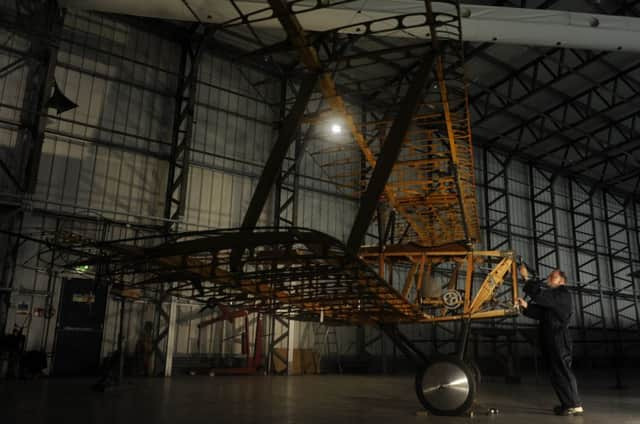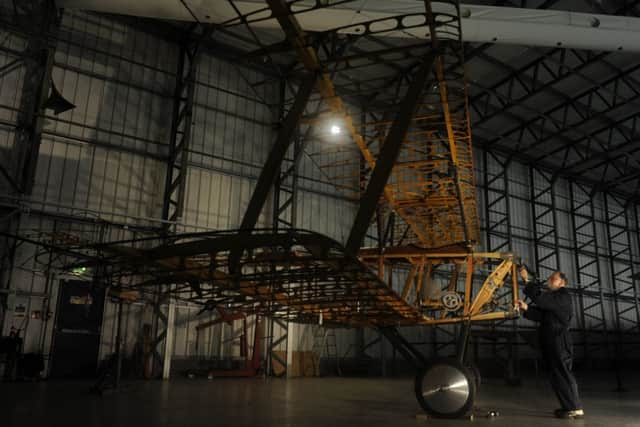Team of pensioners create WWI plane from scratch


Their labour of love has so far taken 11 years, during which time five of the retired construction crew have passed away.
The team of up to 20 volunteers, all aged in their 70s and 80s, have built the craft from scratch at East Fortune airfield using original blueprints from 1916.
Advertisement
Hide AdAdvertisement
Hide AdThe Sopwith 1½ Strutter is being made largely from wood, rather than modern aluminium, in a sign of the lengths gone to creating a rare biplane virtually identical to the original model.


A milestone in the decade-long construction project was achieved yesterday, with a nine-cylinder engine sourced from Australia arriving at the East Lothian site.
Kenneth Sharp, 71, from Port Seton, said the builders, who include a retired surgeon, Concorde pilot and a chemist, spend two days each week working on the plane.
He said difficulties in sourcing aircraft-quality materials had forced them to look as far afield as Australia, Canada and the United States for parts. About £36,000 has been spent on the project to date.
Mr Sharp – who was an operator at Cockenzie power station – said: “The Museum of Flight wanted to build this originally, but with money restrictions they decided they couldn’t. So we said we’d carry on.
“It’s going to fly – it’s not a museum piece. Everything has been certificated to fly. It’s been an interesting hobby.”
All the volunteers are members of the Aviation Preservation Society of Scotland. With two years’ work left, they’re all excited at how it is taking shape. “I want a shot,” says Kenneth looking forward to the day it’s finished.
The original planes would have been built in a matter of weeks – before being sent to northern France to fight ace German pilots in deadly dogfights. At the time, the Sopwith was one of the most advanced machines in the world. Mr Sharp added: “This was the first plane that could fire through the propellor and it had air brakes as well, which was a novel thing at the time. It was the top of the range at the time in fighter planes. It was a tricky aeroplane to fly.
Advertisement
Hide AdAdvertisement
Hide Ad“They were pretty unstable, but they were supposed to be because they’re fighter planes. They didn’t give the crew parachutes because they thought they would be cowards and not fight the enemy..”
Finding the £8000 needed to buy the flying wires joining the plane’s wings is the next great challenge. The society would welcome any donations. More details are available by visiting www.apss.org.uk.
First allied aircraft with machine gun in front of pilot
THE Sopwith 1½ Strutter was a British one or two-seat biplane built during World War One.
The model was the first allied aircraft to have a fixed Vickers machine gun in front of the pilot, made possible by the invention of a interrupter gear that allowed the gun to fire through the propeller as it rotated.
The name “1½ Strutter” came from the one-and-a-half pairs of struts supporting the top wing.
The two-seater aircraft was produced as both a fighter and bomber.
More than 4000 were built, with production split between English and French factories. The Strutter was succeeded by the better know single-seater Sopwith Pup and Sopwith Camel.
Wingwalkers set to thrill airshow fans
The world’s only formation wingwalking display team were set to dazzle spectators at Scotland’s Airshow today.
Advertisement
Hide AdAdvertisement
Hide AdBreitling Wingwalkers will perform a sequence of formation loops and rolls, while daring members perform acrobatics on the wings.
Crowds of around 10,000 will have their eyes on the skies as a series of spectacular aircraft soar above East Fortune.
A supersonic RAF Typhoon, a Supermarine Spitfire and Hawker Hurricane from the Battle of Britain Memorial Flight, a Bell UH1 Huey helicopter, a Sea King chopper and a Second World War Swordfish torpedo bomber biplane from the Royal Naval Historical Flight are among the star turns.
Steve McLean, the museum’s general manager, is this year overseeing his first airshow.
He said: “As always, we have a fantastic line-up of entertainment both on the ground and in the air to ensure that the event lives up to its reputation as one of Scotland’s best family days out.”